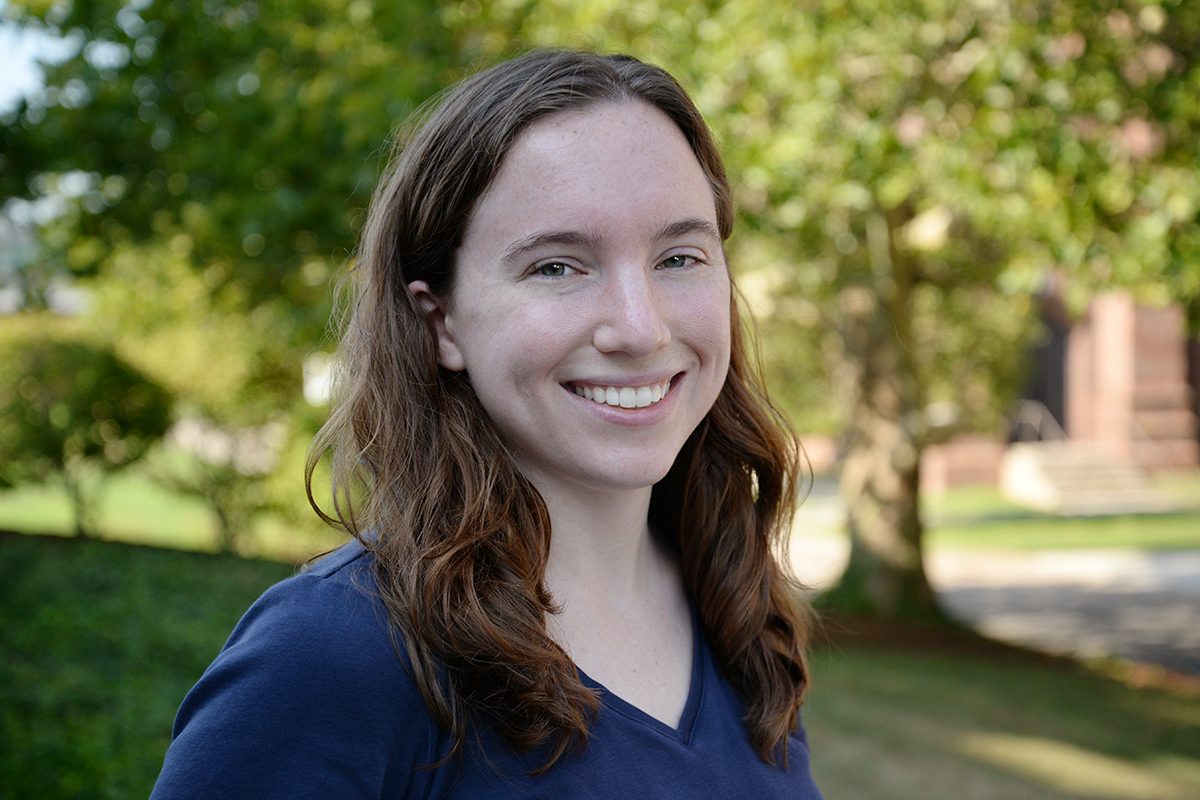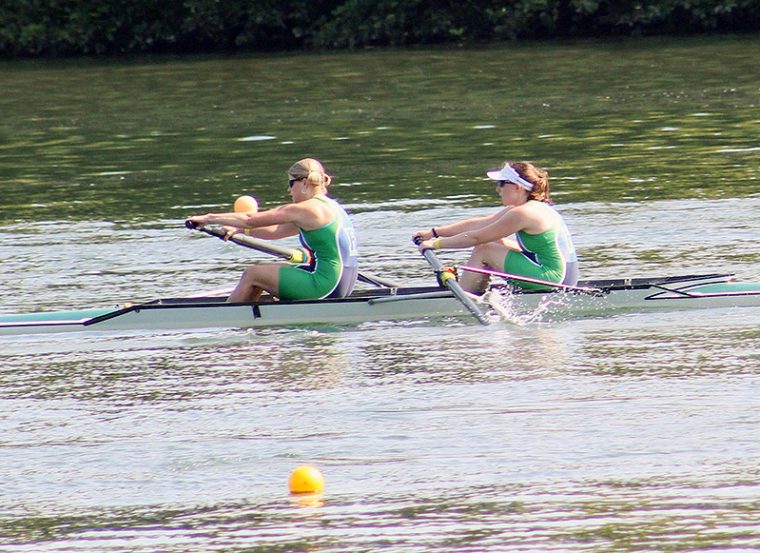Faculty Spotlight: Michelle Personick

In this Q&A, we speak with Michelle Personick, assistant professor of chemistry, assistant professor of integrative sciences. Personick, who joined the faculty at Wesleyan in 2015, is interested in developing tailored metal nanomaterials that improve the clean production of energy and enable the efficient use of energy resources. Her work has recently been published in the journals Particle and Particle Systems Characterization and American Chemical Society Catalysis.
Q: Professor Personick, how would you describe your main research interests?
A: The main research areas in my group are controlling the shape and composition of noble metal nanocrystals, and exploring the use of these nanoparticles as catalysts to improve the efficiency and selectivity of reactions that are important in chemical industry and in energy production.

Q: When did you develop an interest in chemistry?
A: I’ve always been interested in science in general, but it was more a broader interest than a specific focus on chemistry. There was actually a period of time in high school when I wanted to be a particle physicist. I chose chemistry after writing an essay about a cool new light-controlled nanoparticle cancer treatment for a class my senior year in high school.
Q: What attracted you to Wesleyan and how has your experience been here over the last couple years?
A: I had a really positive small liberal arts college experience at Middlebury, where most of my professors knew who I was and cared about how I was doing in their class. Once I decided I wanted to be a professor, I knew that was the type of environment I wanted. In the different courses I’ve taught in my first two years, I’ve found the atmosphere at Wesleyan to be well-matched to pursuing that kind of teaching philosophy. What attracted me to Wesleyan specifically are the unique research opportunities that come out of having a small, but strong, graduate program in addition to being a top-tier undergraduate institution. The advanced research instrumentation here at Wesleyan, such as the electron microscopy facility, is also crucial to our ability to successfully carry out our research. I’d always wanted to work primarily with undergraduates once I set up my own research lab, but having even just two graduate students in that lab as well makes an enormous difference in the level of research I’m able to carry out. In turn, that creates an environment in which the very talented undergraduates I’ve had in my group so far have the opportunity to work on independent projects that get published in peer-reviewed journals and that are well-received by other scientists at major conferences. It’s been very rewarding over the last two years to get our lab up and running and to begin to see the results of the hard work put in by all of my research students, undergraduate and graduate.
Q: What are “noble metals” and what is your interest in them?
A: Chemists refer to elements as “noble” when they tend not to react with other atoms or molecules. For example, there are the “noble gases,” like helium, which are in the last column of the periodic table and are largely unreactive. Different groups of scientists include different metals in the set of “noble metals,” but in general, they’re the metals that are less likely to corrode in acid or oxidize in oxygen. As a result, they include the metals we usually see in jewelry and coins, such as gold, silver, platinum, and palladium. However, it’s a bit deceptive to think of the noble metals as unreactive, because these materials do react with certain molecules in ways that are enormously important for processes ranging from the production of plastics to the operation of the catalytic converters in cars.
Q: What can your research contribute to “the real world?”
A: Industrial chemistry is one of the largest consumers of energy resources. As the demand for the products of chemical industry—such as plastics and pharmaceuticals—continues to grow at a rapid pace, it’s critical that chemists and chemical engineers come up with approaches for making these products in a way that’s more energy efficient. There are two main ways to approach this challenge, and both involve the use of catalysts. One approach is to design catalysts that lower the temperature required for a chemical process to take place, so that you don’t have to spend energy to heat an industrial reactor to hundreds of degrees. The other major approach is to make catalysts that improve the selectivity of a reaction, so that you get the product you want and don’t waste feedstocks, which are derived from energy resources, by creating a lot of unwanted byproducts.
The behavior of nanoscale metal catalysts is fairly complex, and it turns out that the performance of these materials is strongly influenced both by their shape and by their composition. In my lab, in addition to pushing the boundaries of nanoparticle design, we also explore the fundamental chemistry of how different nanomaterials behave in challenging model catalytic reactions in order to develop guiding principles for creating better industrial catalysts.
Q: Where are you from and where did you attend college?
A: My undergraduate degree is from Middlebury College in Vermont, and I did my graduate work at Northwestern University in Illinois. I’m originally from New Jersey, so this is the closest I’ve lived to where I grew up since I left for college. I have a BA in chemistry, with a minor in philosophy, and my PhD is in inorganic chemistry, which is a subfield of chemistry that focuses a lot on metals, but also includes the enormous part of the periodic table that isn’t carbon.
Q: Has being a “woman in science” been rewarding or challenging?
A: I’ve found it to be rewarding overall, though I’ve been lucky to have done all of my professional training in research groups and departments that were incredibly supportive of women in science, beginning as an undergraduate. I was the only woman in most of my upper level undergraduate chemistry courses, but there was a strong sense among our small group of majors that we were all in it together, regardless of gender.
Q: Are you involved with Wesleyan Women in Science (WesWIS)?
A: I think it’s great, and important, that WesWIS exists and that there is very strong participation in that group. I’ve given a tour of my lab that was hosted by WesWIS in conjunction with a tour of the Etson Lab in physics. I too, absolutely encourage my female students to pursue careers in the sciences. The more women (and underrepresented minorities) who pursue careers in the sciences, the more younger female and underrepresented students will be able to imagine themselves in those roles, and the sciences will begin to diversify.
Q: Out of the lab, what are your hobbies?
A: I do a handful of small things, such as baking and playing board games with friends and colleagues. By far my biggest commitment outside of the lab, though, is that I row with the Riverfront Recapture masters racing team in Hartford. The women on the team range in age from 23 to 69 and we race competitively throughout the northeast, as well as at the U.S. Rowing Masters National Championships, which were most recently in Oak Ridge, Tenn. Rowing is a very technical sport, so it requires a lot of focus and commitment, and it’s a great way to reset after a busy day in the lab or in the classroom.

